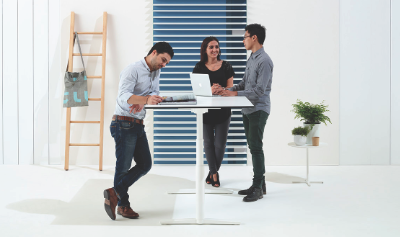Adjustable height desks aren’t new, yet it seems demand for this style of flexible workplace furniture is gathering momentum.
You may have noticed Steven Yu’s StandDesk on Kickstarter earlier this year, in which 1,697 backers pledged $649,244 to fund further development of the range.
Another series currently seeking funds is iMovR’s Upsilon workstation, an electric sit-stand desk that has already raised most of its $20,000 goal.
What’s driving this renewed interest in flexible desks? It’s plausible that employee wellness and motivation factors have a large part to play, not to mention the likelihood of enhanced productivity that healthier, happier workers can bring.
According to StandDesk, research has suggested that standing during office work can lead to 10% more productivity, buoyed by sideline benefits including higher energy levels and improved concentration. The firm also cites research from Dr. John Buckley of the University of Chester, which found: “If you stand 3 or 4 more hours 5 days a week, over the course of a year, it’s the equivalent of running 10 marathons.”
Nine years seated
Office furniture company Schiavello, based in Melbourne, Australia, has just launched its own sit-stand range – Krossi. The company began campaigning for flexible furniture back in 2008 with its collection of freestanding, flexible height meeting tables (pictured below left).
 “Based on the success of this design, Krossi has expanded into a height adjustable table and workstation system that considers people’s health and wellbeing in the workplace,” said Raffaele Tigani, General Manager at Schiavello International.
“Based on the success of this design, Krossi has expanded into a height adjustable table and workstation system that considers people’s health and wellbeing in the workplace,” said Raffaele Tigani, General Manager at Schiavello International.
Raffaele added: “As companies are realising the tangible benefits of focusing on health and wellness in the workplace, office furniture that encourages movement, especially workstations with height adjustability are increasingly popular for both wellness and functional reasons.”
Having researched the effects extensively, Schiavello found that the average office worker spends 80% of their work hours sitting. It is estimated that people spend around 80,000 hours (or nine years) seated over the course of their working life, which can contribute to various health problems including back pain, headaches, and blood pressure complaints.
Improved wellbeing
Following a 12-week study by Alfred Health, in which 100 employees used a sit-stand workstation, sitting time was reduced from 91% of the working day to 54%. Staff reportedly noted multiple benefits, including ‘improved health and wellbeing, greater concentration or focus, greater productivity, reduced pain and discomfort and reduced fatigue’.
With the launch of its Krossi range, Schiavello lays claim to the first Australian designed sit-stand workstation. But as the benefits become more widely known, it certainly won’t be the last of its kind.
“People are an organisation’s most important assets,” added Tigani. “Companies invest heavily in welfare packages to attract and retain the best talents. Beyond health insurances and wellness programmes, it is beneficial for companies to rethink workspace design in consideration of employees’ holistic wellbeing.
“By giving people the space, tools and technologies they need to be effective, the holistic workplace can drive a fundamental value back to the organisation.”


 Dr. Gleb Tsipursky – The Office Whisperer
Dr. Gleb Tsipursky – The Office Whisperer Nirit Cohen – WorkFutures
Nirit Cohen – WorkFutures Angela Howard – Culture Expert
Angela Howard – Culture Expert Drew Jones – Design & Innovation
Drew Jones – Design & Innovation Jonathan Price – CRE & Flex Expert
Jonathan Price – CRE & Flex Expert











